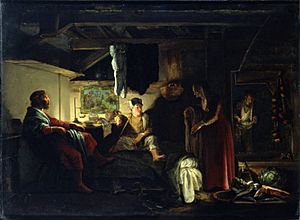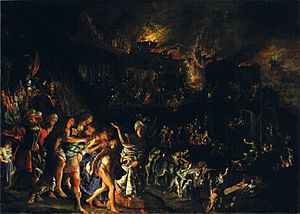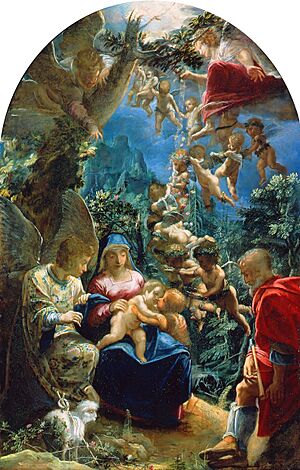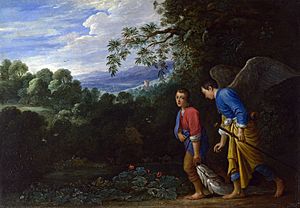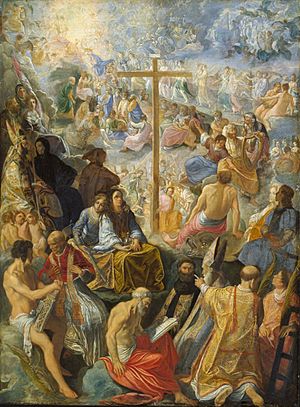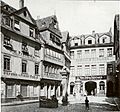Adam Elsheimer facts for kids
Quick facts for kids
Adam Elsheimer
|
|
|---|---|
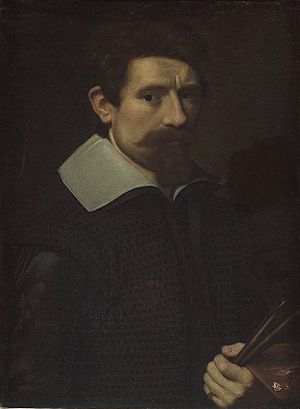
Self-portrait at the Uffizi Gallery, Florence
|
|
| Born | 18 March 1578 |
| Died | 11 December 1610 (aged 32) |
| Resting place | San Lorenzo in Lucina, Rome |
| Nationality | German |
| Education | Friedrich Brentel Johann Rottenhammer |
|
Notable work
|
The Flight into Egypt |
| Spouse(s) | Carla Antonia Stuart (1606-1610) |
| Elected | Accademia di San Luca, Rome (1606) |
| Patron(s) | Francesco Maria del Monte |
Adam Elsheimer (born March 18, 1578 – died December 11, 1610) was a German artist. He worked in Rome, Italy, and was very important in the early 1600s. Even though he died young at 32, his work greatly influenced Baroque painting.
He made only a few paintings, but they were special. They were usually small and painted on copper plates. These were often called "cabinet paintings." Elsheimer was great at showing different kinds of light and creating new ways to paint landscapes. Famous artists like Rembrandt and Peter Paul Rubens learned from him.
Contents
Adam Elsheimer's Early Life
Adam Elsheimer was born in Frankfurt am Main, Germany. He was one of ten children. His father was a master tailor. Their house was near a church where a famous artwork by Albrecht Dürer was displayed.
Adam became an apprentice to an artist named Philipp Uffenbach. An apprentice is someone who learns a skill from a master. He probably visited Strasbourg in 1596. When he was 20, he traveled to Italy through Munich in 1598.
Time in Venice
We don't have many records of Elsheimer's time in Venice. However, it's clear that Venice influenced his art style. He likely worked with Johann Rottenhammer, another German painter living in Italy. Rottenhammer was one of the first German artists to focus on small "cabinet paintings."
Elsheimer's earliest small paintings on copper might have been made before he reached Italy. But Rottenhammer's style clearly shaped his later work. Elsheimer is thought to have created important pieces in Venice. These include The Baptism of Christ (now in the National Gallery, London) and The Holy Family (in Gemäldegalerie, Berlin). These paintings show the influence of Venetian artists like Tintoretto and Paolo Veronese.
Life and Art in Rome
In early 1600, Elsheimer arrived in Rome. He quickly made friends with people Rottenhammer knew. One important friend was Giovanni Faber, a doctor and collector from Germany. Faber was in charge of the Vatican Botanical Garden. He was also part of a group of smart people called the Accademia dei Lincei. This group studied natural sciences.
Another friend was Paul Bril, a landscape painter from Belgium. Bril was a witness at Elsheimer's wedding. He even painted a picture with Elsheimer. Like Faber, Bril had lived in Rome for a long time and had become Catholic, just as Elsheimer did later.
Both Faber and Bril knew Peter Paul Rubens, who was also in Rome in 1601. Rubens became another friend of Elsheimer's. Later, Rubens wished Elsheimer had created more art. Elsheimer also knew David Teniers the Elder, who was Rubens' student. They might have even lived together.
In 1604, a Dutch writer named Karel van Mander wrote about Elsheimer's work. He praised Elsheimer but said he worked slowly and didn't make many drawings. Elsheimer also spent a lot of time in churches, studying the works of famous artists. Other writers said he had an amazing memory for what he saw. They also described him as a kind person. After Elsheimer died, Rubens wrote that "he had no equal in small figures, landscapes, and in many other subjects."
Elsheimer's Family and Challenges
In 1606, Elsheimer married Carola Antonia Stuarda. She was from Frankfurt, like him, and had Scottish ancestors. In 1609, they had a son.
Carola was the widow of another artist. After Elsheimer died, she remarried an Italian artist within a year. Elsheimer became Catholic by 1608. He joined the Accademia di San Luca in 1606. This was the main group for painters in Rome. He gave them a self-portrait, which is his only portrait and only painting on canvas. It is now in the Uffizi Gallery. Even though he was famous and talented, he faced money problems throughout his life.
Elsheimer's painting Tobias and the Angel (from 1602–1603) was very popular. It showed a new way of painting landscapes. This painting was copied by Hendrick Goudt and shared across Europe. However, Elsheimer's relationship with Goudt was difficult. Elsheimer borrowed money from Goudt. Some say this led to Elsheimer being put in Debtor's prison for a short time. After Elsheimer died, Goudt owned several of his paintings. Goudt made seven copies of Elsheimer's works, which helped spread his influence. Most of Elsheimer's original paintings were small and kept in private rooms, so not many people saw them.
Elsheimer liked to choose unusual subjects for his paintings. For example, Jupiter and Mercury in the house of Philemon and Baucis (around 1608) was based on a story from Ovid. No one had painted this story before. Other new subjects included The Mocking of Ceres and Apollo and Coronis. Some of his religious scenes were more common, but he often chose unusual moments to paint, like St Lawrence prepared for Martyrdom.
Elsheimer's Artistic Influence
Elsheimer was a perfectionist and may have suffered from sadness. This meant he didn't create many paintings, even though they were small. Only about forty paintings are now believed to be by him. He also tried making etchings, but they weren't very successful. However, other artists and collectors highly valued his work for its quality.
He directly influenced other Northern European artists who were in Rome. These included Paul Bril, Jan Pynas, Leonaert Bramer, and Pieter Lastman. Lastman was later Rembrandt's teacher and was likely in Rome by 1605. Rembrandt's first known painting seems to be inspired by Elsheimer's work. Some Italian artists, like Carlo Saraceni, also showed Elsheimer's influence in their paintings. Peter Paul Rubens, who owned at least four of Elsheimer's works, knew him in Rome and praised him highly after his death.
Elsheimer influenced art in three main ways:
- Night Scenes: His paintings of night scenes were very original. He used light in a subtle way, different from Caravaggio. He often used many light sources and made the light change gently. Important parts of his paintings were often in less brightly lit areas.
- Poetic Landscapes: He combined beautiful landscapes with large figures in the front. This made the landscape much more important than it had been since the early Renaissance. His landscapes were realistic but also poetic. They helped shape the landscapes painted by artists like Poussin and Claude. His way of painting large figures with a landscape background influenced later artists like Peter Paul Rubens and Anthony van Dyck. Soon after his death, English collectors, including King Charles I of England, really liked his work. More than half of his paintings have been in English collections at some point.
- Combining Styles: Elsheimer successfully blended Italian art styles with the German traditions he learned. His paintings often show the start of important changes, but without too much drama. His figures were shorter and sturdier, not like the perfect figures in classical art. Their poses and expressions were simple, more like older Dutch paintings than the "beautiful figures" of the Italian Renaissance.
Where to See His Works
The largest collection of Adam Elsheimer's work is in Frankfurt, Germany. The Alte Pinakothek in Munich has two of his best night-scene paintings. Other paintings can be found in Berlin, Bonn, Dresden, and Hamburg. The National Gallery, London has three of his paintings. Others are in the National Gallery of Scotland in Edinburgh, Apsley House, Windsor Castle, Petworth House, the Wellcome Library, and Liverpool.
In 2006, an exhibition in Frankfurt, Edinburgh, and London brought almost all his paintings together. You can also find his drawings in places like the Louvre in Paris and Edinburgh.
Only two of his works are on public display outside Europe. One is The Flight into Egypt at the Kimbell Art Museum in Fort Worth, USA. The other is The Mocking of Ceres, which is now in the Agnes Etherington Art Centre in Kingston, Ontario, Canada. This painting was badly damaged by fire at some point. It was part of a gift from the Netherlands to Charles II of England in 1660.
Images for kids
See also
 In Spanish: Adam Elsheimer para niños
In Spanish: Adam Elsheimer para niños
- List of German painters


